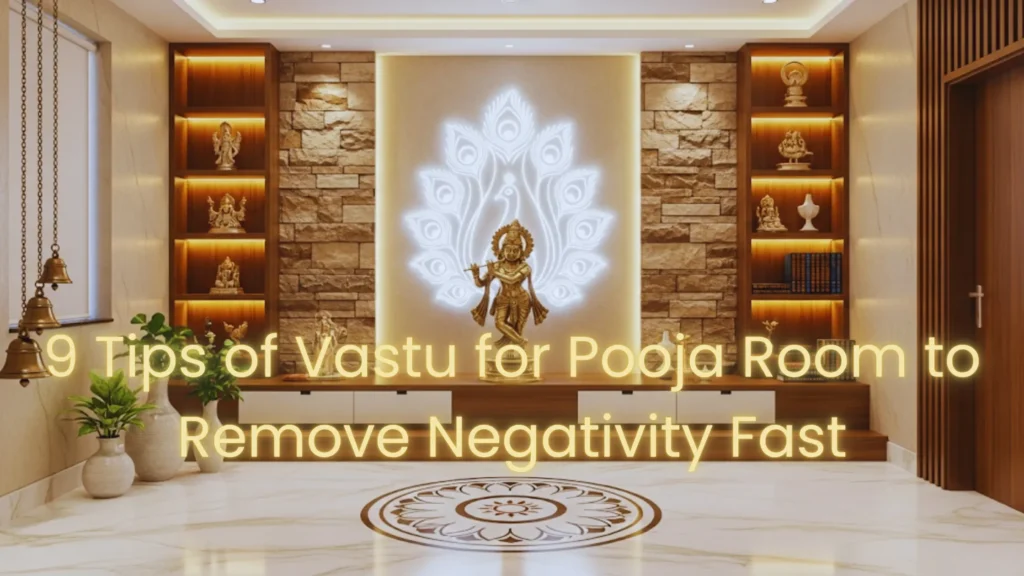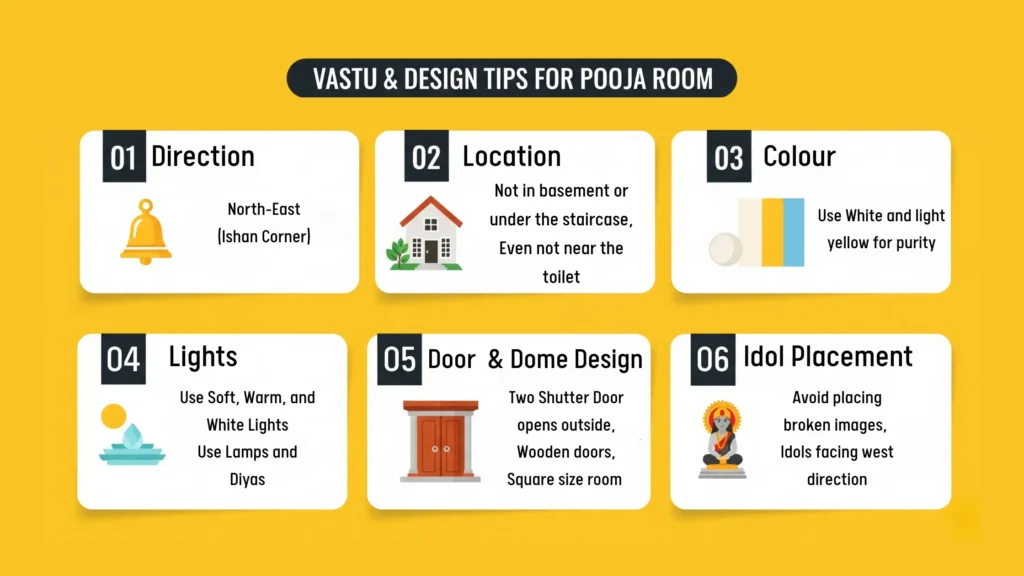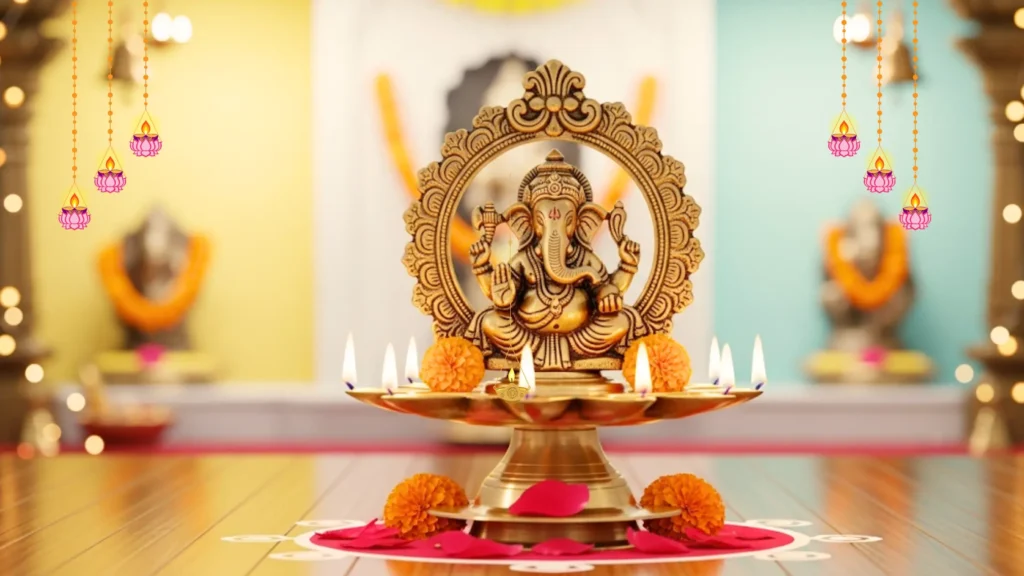
A peaceful and spiritually energized pooja room is an important element of Indian homes. However, many homeowners face struggles over where to place the pooja room, which direction the deities should face, or what design principles to follow for maintaining positive energy. Over time, these uncertainties can lead to Vastu dosh, energy imbalance, and even cause emotional discomfort.
At this point, Vastu for pooja room becomes essential for every household. Vastu Shastra, also known as ancient architectural science, offers time-tested guidance to help you design a spiritually balanced and energetically harmonious space. Aligning your holy space with Vastu Shastra helps you to attract peace, prosperity, blessings, and divine energy, whether you are renovating or building a new home with a puja corner.
This guide helps you cover every aspect of Vastu for pooja room—from pooja room design to idols or deities facing direction as per Vastu—while providing the practical solutions to common pain points, backed by expertise and spiritual tradition.
Vastu shastra is the foundation for creating a pooja room that truly feels divine. It’s not just about creating a designed structure—it’s about building a space that supports your prayers, peace of mind, uplifts the energies, and connection with the divine. When a homeowner adheres to the correct Vastu Shastra for Home Temple, the entire household is naturally lifted by the peaceful, positive energy that draws everyone in.
When the principles of Vastu are ignored, many people often report discomfort at home, experience frequent disturbances, or face financial instability. Practicing Vastu for pooja room can serve as a powerful remedy, aligning your spiritual space with peace, positivity, and universal harmony.

Pooja Room Vastu involves more than architectural placement—it’s about aligning the cosmic energy, serenity and spirituality, and aesthetic of design that uplifts your overall home rather than distracts.
Here are the key guidelines of Vastu principles for your pooja room:
Principles of Vastu for pooja room are not only connected with ancient indian science but also supported by modern architects and the interior designers who are familiar with Vedic principles. Ignoring these principles may lead to spiritual recession; it’s a common concern in middle-class homes where Vastu is often compromised.
For a deeper understanding of how Vastu principles enhance overall well-being at home, check out these Vastu Tips for Home to enhance health and happiness in the home.
Selecting the Puja Room Location as per Vastu is important to ensure spiritual and energetic balance within your home. According to Vastu Shastra, the North-East (Ishan corner) is the most auspicious direction for a pooja room.
When you follow Vastu for pooja room correctly and place the mandir in the Ishan Corner or North-East direction, it acts as a magnet, attracting peace, success, and divine favor. In contrast, placing it in the South or near a bathroom may cause energy reduction, resulting in anxiety, poor concentration, or family disputes.
Tips for an ideal pooja room location:
Designing a pooja room is not just about construction and giving an elegant look—it’s about creating an energy field that amplifies your prayers and intention. Following pooja room design as per Vastu can help you create a space that promotes calmness, mindfulness, and divine focus.
Here’s what an ideal design includes:
Aligning the Vastu for pooja room, such designs uplift the spiritual aura of your home and bring calmness into your daily rituals. Many families report enhanced peace and emotional stability after improving their pooja rooms using Vastu principles.

Many homeowners overlooked the lighting and colours of the pooja room, as they are important elements of Vastu for Pooja Room; both elements should contribute to peace, focus, and balance the spiritual energy.
Following the proper guidelines of Vastu for pooja room, transform your home to promote inner peace and devotion.
A common mistake that many homeowners make follow, that placing the idols in the wrong direction, leading to diminished effects of prayers and spiritual practices. The god face direction as per Vastu should always be given utmost priority.
Applying the correct aspects of Vastu for pooja room can significantly enhance the sanctity and effectiveness of your prayers.
In many homes, where the space is limited, Vastu Principles are unintentionally compromised, resulting in doshas, leading to an energy imbalance that can affect well-being and prosperity.
By understanding the Vastu for pooja room and correcting these issues using remedies, homeowners can easily restore spiritual balance without needing major renovations. A Vastu expert can guide you with personalized solutions for your space.
Implementing the Vastu for Pooja Room into your home is more than just a part of tradition—it’s a holistic way to improve mental clarity, prosperity, and household harmony.
Every component contributes to creating a positive and peaceful environment, whether it’s choosing the right location, correcting the idol’s direction, or choosing the calm colours.
Applying the Vastu correctly transforms your home into a divine powerhouse that supports the soul and invites the blessings into every corner of your life. Take the first step today and invite the positive energy into your home temple with these principles through Samanvay Vastu—and watch your spiritual energy flourish.
Pooja Room Vastu emphasizes clean design, proper deity orientation, and clutter-free sacred spaces. Avoid placing pooja rooms near bathrooms or bedrooms, and maintain symmetry.
Vastu Shastra for Home Temple works by aligning the pooja room with natural energies. It guides where to place the temple, how to position idols, and which directions to follow to create a peaceful, positive space. This helps improve focus during prayers and brings harmony and blessings into the home.
Choosing the right location for the pooja room as per Vastu ensures that your home temple attracts positive energy and supports spiritual growth. The North-East is considered as best direction for a pooja room, also known as the Ishan Corner.
Pooja room lights and pooja room colour as per Vastu, play a big role in creating a calm and spiritual atmosphere. Soft lighting brings warmth and focus during prayers, while light colours like white or yellow promote peace and purity.
It helps in feeling more connected with divine energy at the time of prayer.
According to Vastu, following the pooja room design helps in creating a peaceful and sacred space that supports your prayers and spiritual energy.
By following these guidelines, you can ensure that your pooja room is filled with positive energy and prosperity. Start making changes today and enjoy a peaceful, balanced environment!
Stay connected with Samanvay Vastu on Instagram, Facebook, and YouTube for more Vastu tips, client success stories, and daily inspiration.
For any Queries or consultation: Contact Us at: +91 9891377963 or Email Us